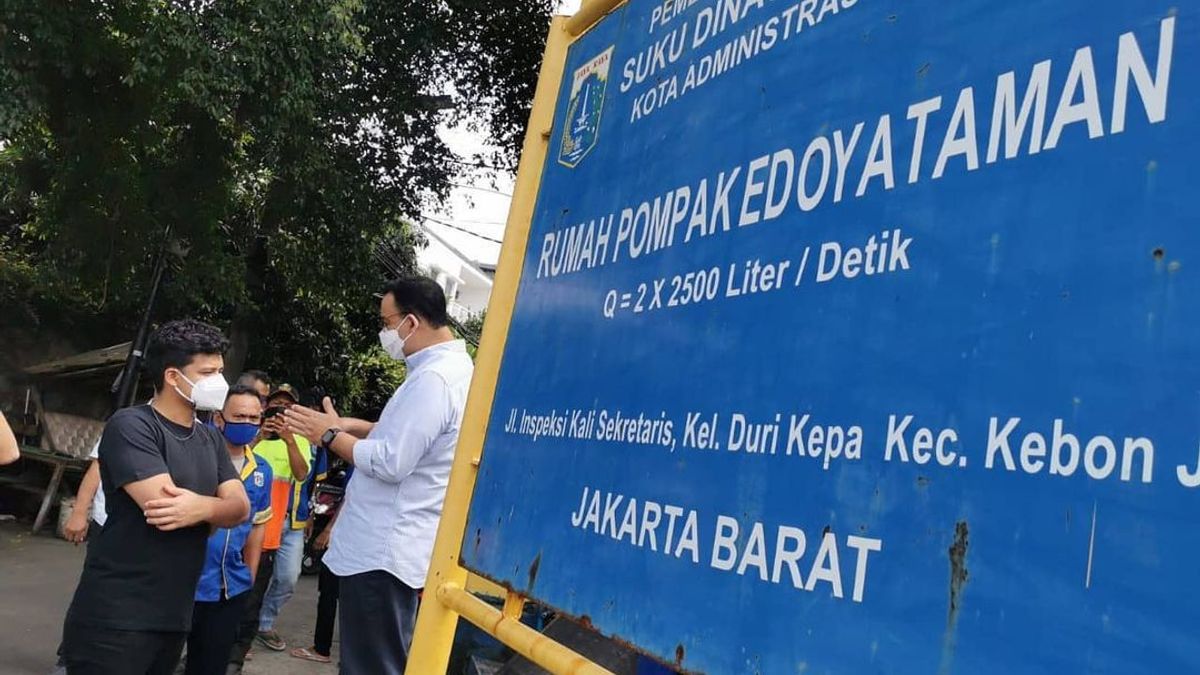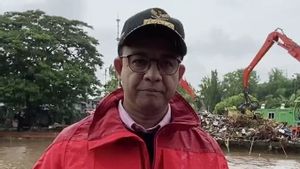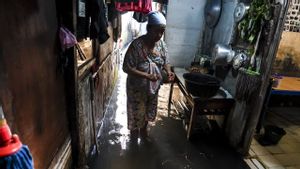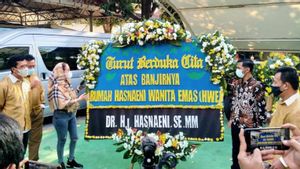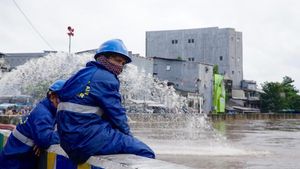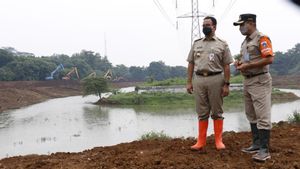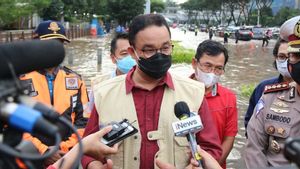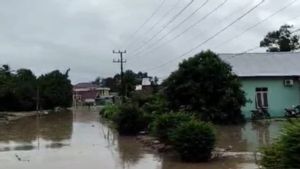JAKARTA - DKI Jakarta Governor Anies Baswedan has been in the spotlight after the floods that occurred on Saturday, February 20. He is considered not to have worked optimally to prevent flooding, even though he had made a number of promises to tackle the flood disaster.
A number of areas in DKI Jakarta experienced flooding with varying heights on Saturday, February 20. Knowing that many areas were affected by the flood, Anies held a coordination meeting at Manggarai Water Gate, South Jakarta.
After reviewing the water level from his staff's report, Anies said that the flooding in the capital city, especially in East Jakarta and South Jakarta today was caused by extreme weather and high rainfall.
He said high rainfall occurred in a number of areas, for example in Pasar Minggu reaching 226 mm per day, in Sunter Hulu 197 mm, at Halim Perdanakusuma up to 176 mm, Lebak Bulus 154 mm.
"All numbers above 150 are extreme conditions. On a scale division, there is heavy rain up to 100 mm, then, 100 mm-150 mm is very heavy and above 150 mm is extreme rain," said Anies.
This rainfall, he continued, is not in accordance with the capacity of the drainage system in the capital city, which is built with a rainfall capacity of between 50 and 100 millimeters per day. This then caused the overflow to occur and the flood finally inundated a number of areas.
"The capacity of the drainage system in Jakarta ranges from 50 to 100 mm. If it rains above 100 mm per day, then inundation will definitely occur because the capacity is limited to 100 mm," he said.
Anies' promise in tackling floods
The former Minister of Education and Culture (Mendikbud) once had a target for waterlogging in the capital city due to the rain receding within 6 hours after the rain stopped. This belief emerged after he claimed that the floods that occurred during the recent rainy season were well controlled.
"Our principle has two dimensions. First, if it rains heavily, then it must be ensured that if a puddle appears, 6 hours after the rain stops, the puddle is targeted to be dry," said Anies some time ago.
However, this promise was missed when the flood occurred last Saturday. Because even though the rain had stopped for up to six hours, a number of areas were still flooded and only receded the next day or Sunday, February 21st.
Anies argued that the flood was caused by shipments from other areas that filled the river in Jakarta.
Not only that, but Anies also promised to make infiltration wells in people's housing. This was one of the solutions to flooding from Anies, who at that time was advancing in the DKI Jakarta Pilgub with Sandiaga Uno and conveyed it during a campaign at Pesing Garden, North Kedoya Village, Kebon Jeruk, West Jakarta in January 2017.
This infiltration well needs to be made to absorb rainwater into the ground. "Where the maximum possible rainwater is put into the ground. And this requires a lot of work, because currently there is still very little effort to put water into the ground," he explained.
This program also made Anies criticize Basuki Tjahaja Purnama's flood management efforts. The reason was that during Basuki's leadership or familiarly known as Ahok, flood management was carried out by channeling rainwater into the sea.
Meanwhile, he considered that what is needed now was to put water into the ground. "What is being done at this time is as much as possible to channel water to other places. That is where, into the sea, channels are made to accelerate the water to the sea as quickly as possible," he said.
"Actually, what is needed is water to enter the ground. Therefore, what we will do is increase the absorption wells. And these absorption wells are serious absorption wells," he added.
Ahok gives advice to Anies
The floods that did not recede for six hours and occurred in many locations made Ahok, who once led Jakarta from 2014 to 2017, to speak up. He considered that the river normalization program that had been launched for a long time should be completed by Anies.
"The programs from the Ministry of Public Works and Housing (PUPR) and also BBWSCC (Ciliwung Cisadane River Basin Main Station) and also the World Bank, are all resolved. Either to use sheet pile because people's houses are already crowded and the landslide structure condition or even use natural methods," Ahok told VOI.
Ahok emphasized that river normalization must be carried out. If you want normalization or what is called naturalization by DKI Governor Anies Baswedan, it must be done by ensuring the return of the watershed (DAS).
"If you want to return it to its original watershed shape, where the waterway is maximized, all buildings that have to be in the watershed area will be demolished. In Jatinegara there are shophouses that we have to demolish, let alone houses without permits which occupy the watershed," said Ahok, giving an example of flood management in his era leading the capital city of DKI.
However, Ahok emphasized that the river normalization must be accompanied by the DKI Jakarta Provincial Government's program to provide shelter for Jakarta residents who have to be evicted from riverbank areas. Flats, the solution.
"Just provide a lot of affordable flats. Lifetime ownership, permanent residence permit, and the low payment. If you're asked the people to buy, people with UMP salary or especially people with an uncertain salary cannot afford to buy a 0 percent house? Many houses are not selling at 0 percent interest. Let alone 0 percent DP, people with UMP salary cannot afford the main installments," said Ahok.
Ahok advised the governor of Jakarta to carry out programs including flood management with courage. Without worrying about popularity.
"In DKI everything is complete. It is up to us to be brave or not to run the existing program and if there is no change in the study of the existing program. Just do it. Everything is done to clean up transportation, floods and administer social justice only. It's not a matter of being popular or not. This is a matter of carrying out duties in accordance with the oath of office and professionally or not while in office," he said.
SEE ALSO:
Anies is considered as too much self-imaging
Meanwhile, the environmental activist, Chaerudin or familiarly known as Babe Idin, asked Anies not to blame the water for flooding in the capital that has not been ended. The flooding that occurred this weekend, he said, should be a reflection of what he has been doing in Jakarta so far.
"Hopefully DKI Jakarta's number one hears me talking about this. If there is a flood, we don't blame the water or the river. But the way to handle that must be prioritized," said Babe Idin - who is also the supervisor of the Environmental Farmers Group (KTLH) - as quoted from his written statement.
"Normalization is okay. But don't cut down the bamboo trees later and replace them with concrete," he added.
Academic Ade Armando also gave harsh criticism. He assessed that Anies was only busy self-imaging without knowing which priorities should be worked out for the interests of the citizens of the capital.
Most noticeably, Anies Baswedan posted a photo of himself and a woman in the Cipinang area, East Jakarta some time ago. In the photo on the @aniesbaswedan Twitter account, you can see a comparison between 2017 where the area was still flooded, and 2020 when it was flood-free.
"This is the most ridiculous illustration, the event of visit to Cipinang Melayu Sub-District, East Jakarta on last February 9. Anies prided himself on describing the area as now already flood-free," said Ade Armando on the CokroTV YouTube channel, Saturday, February 20.
This fact is inversely proportional to the current condition in which the Cipinang Melayu Sub-District is still submerged in floods as high as 1.5 meters.
"It is described that this was achieved because of the Grebek Lumpur program at the Sunter river. So the mud was lifted and a new embankment was built. His arrogance was immediately answered by nature. In mid-February, Cipinang Melayu Sub-District was hit by a flood of up to 1.5 meters high," said Ade.
This social media activist added that Anies's policies during his tenure did not have a major effect on flood management as did his predecessor, Basuki Tjahaja Purnama alias Ahok.
Ahok, emphasized Ade Armando, applies river management systematically by widening the river basin (DAS) so that water can quickly flow into the sea.
To support this program, Ahok then moved residents along the river to flats, including residents of illegal buildings. This program was insulted by Anies as against Sunnatullah.
"In all over the world, Anies said, water from the sky should be absorbed into the earth not channeled into the sea, because that's why he said what to build should not be giant culverts but to ensure that water is immediately absorbed into the ground. That way there is no need for eviction of illegal settlements on the riverbanks," said Ade.
Naturalization is the right policy to support water programs that must be absorbed into the earth and not returned to the sea. The problem is, said Ade, this all just a word and has never been realized by the DKI Provincial Government.
"Anies explained that naturalization means replacing river walls from concrete with green areas to protect the ecosystem, but everything is unclear there is no sustainable execution. So normalization is stopped and naturalization has never been carried out," he concluded.
The English, Chinese, Japanese, Arabic, and French versions are automatically generated by the AI. So there may still be inaccuracies in translating, please always see Indonesian as our main language. (system supported by DigitalSiber.id)
